Guy, our newsletter editor, was desperate for copy so when he heard that
Margaret and I had just returned from Thailand he saw an opportunity to
fill some of the void by getting us to write a short article about the
trip. “But Guy, apart from a couple of mildly adventurous episodes our
trip, though very enjoyable to us, was too touristy to be of interest to an
IMC audience used to a diet of wild places and death defying acts of
derring-do”. “Oh don’t worry about that, just tell us the exciting bits”
came the reply. So here goes.
The idea to visit Thailand came from a pub chat with Nick Willis, who
has travelled widely in SE Asia, at the Wye valley meet in July. Nick (and
his wife New) followed this up with many interesting suggestions of things
to see and do in Thailand. So our outline plan was to spend a few days in
each of Bangkok and the northern city of Chiang Mai, and then to hire a car
and spend 12 days wandering around Northern Thailand as the fancy took
us.
I’ll skip the Bangkok bit for now (but see later for some pics) and go
straight to Chiang Mai, a moated and walled city dating back to the
13th century, popular for its architecture (some 120 Wats
(Buddhist temples) and as a centre for adventure activities (trekking,
rafting, caving etc). But the biggest visitor attraction is the enormous
market known as the Night Bazaar and in the centre of this is, somewhat
incongruously, Southeast Asia’s largest outdoor climbing wall (15m high,
16m wide) built to international climbing standards and with an overhanging
section that would severely test IMC’s finest. Having no kit and no
(climbing) partner a wall session didn’t seem a good idea but the office
managing the wall was advertising day trips to a local crag called the
Crazy Horse buttress which included transport, kit hire, and a Thai meal on
the way back, all for the bargain price of 1500 Baht (about £23)… now that
was a good idea! A day’s pass was quickly negotiated with Margaret and all
was set for the following day.
The Crazy Horse buttress is an impressive limestone crag about 30 km north of Chiang
Mai. It has about 90 routes, spread over 13 areas, with an average grade of
6b+ and average height 70 feet. Check it out for yourself at http://www.thecrag.com
 |
| The Crazy Horse buttress – see why? (click on any picture for image in Flickr) |
Our party, consisting of 4 clients and 2 guides from Peak-Rock, was a
bit of a mixed bunch. The clients were Claude (a French alpine ski/climbing
instructor), Martin (an English fireman), Brian (an Irish ‘traveller’), and
me. Claude and Martin were in Chiang Mai on a Thai massage course and had
been out with Peak-Rock before so were able to start climbing right away. I
had to demonstrate that I knew how to top out and lower off before I was
allowed to lead. After these formalities I teamed up with Brian (who hadn’t
climbed outside before) but before I started climbing there was something I
just had to know….what about the snakes?? According to Lonely Planet
there are 6 species of poisonous snake in Thailand, and I didn’t like the
thought of shoving my hand in a crack and disturbing a cobra! “Don’t worry,
we hardly ever see snakes here” said Nye our guide. “… but in the wet
season we do a 3 day climbing trip to a crag where we climb from a raft in
the river, and there it is quite common to see boas on the ledges and it
is a matter of routine to tap the rock before placing your hand in large
holes. But the worse thing is the monkeys who hurl sticks and stones down
on the climbers”. I bet they don’t tell their clients that before taking
the money … but I was reasonably reassured about our present location so I
set about leading some pleasant 5a/b routes, such as this one …
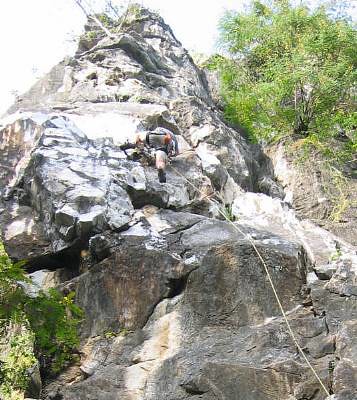 |
| a nice 5b warm up |
Claude was a very strong climber, as his day job would suggest, so there
were plenty of opportunities to follow (or at least try to) more
challenging 6a/b/c stuff like this one…
 |
| Claude leading a 6b into the cave at the Crazy Horse |
The weather was hot, the rock impeccable, and the routes of a
uniformly high quality with much less polish than I was expecting. And, to
cap an excellent day, we were treated to a meal at a roadside restaurant on
the way back to Chiang Mai.
After hiring a car we left Chiang Mai and headed northwest into the
rugged hill country of Mae Hong Son province (75% mountain and forest)
making for Cave Lodge, a ‘must do’ recommendation from Nick & New. A
quick shower stop …
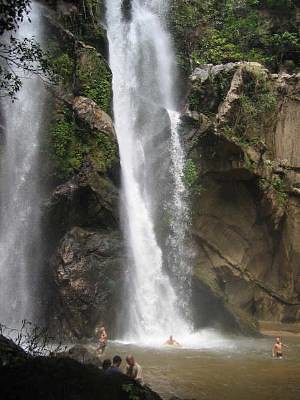 |
| Cooling down under the Mokfa waterfall |
… and then a relentless low gear slog
up the narrow and twisting road to Pai and beyond. As we approach the turn
off to Cave Lodge there is clear evidence of serious recent flooding (land
slides, bridges swept away, riverbeds strewn with trees).
When we reached Cave Lodge our first impression can be best summed
up as “hmm…it’s certainly different”. The lodge is owned by John, a
larger-than-life aussie, who spent his early years in that part of Thailand
exploring its many cave systems and researching the culture of the many
hill tribes living there. He designed and built the lodge himself in the
style and materials used in hill tribe villages. The lodge consists of a
central ‘community’ hall on 3 levels with open frontage overlooking the Nam
Lang river, and surrounded by small bungalows for guests, all set on a
pleasant wooded slope.
The Lodge is an excellent base for all manner of adventure activities,
two of which appealed to us (well, the second one only to me):
trek through the forest to a Karen hill tribe village, hitch a lift on
an elephant to the river, and then return to the lodge on a bamboo raft
a ‘full on’ caving day visiting 3 caves in the area
John provided his ‘Girl Friday’ Put as our guide for the trek. Put
turned out to know everyone in, and everything about, the area. We started
by visiting a Shan hut where the extended family were sitting around what
appeared to be a gigantic wasps nest. The nest had been steamed and the
larvae were being removed to sell as a sought after local delicacy…and
quite tasty too. After a few hours of easy paced walking through the forest
we came to the Karen hill tribe village where time really has stood
still.
 |
| Karen hill tribe village |
The village was incredibly quiet as most people were out harvesting
rice, or so we assumed. We stopped to admire some textiles made in the
village that were lying unattended on a wooden platform and within minutes
women were coming from all directions carrying bundles of stuff they had
made…crikey, what have we started now. So a few quick purchases and then a
hasty retreat to find an elephant. Now, getting on and off an elephant is a
bit tricky, requiring a few exposed and unprotected 4a moves. Once
on board however the ride, though slow and bumpy, is immensely secure
as the elephant is amazingly sure footed over all manner of terrain. After
about an hours travelling we’re somewhat glad to reach the raft on the Nam
Lang river. Bamboo rafts are rudimentary in the extreme, consisting of a
platform of bamboo poles lashed together, a handrail sticking up in the
middle to hold on to, and two poles used for steering. The Nam Lang can
hardly be classed as ‘white water’ in the section we were on, but it
certainly has its quick bits so correct positioning and frantic punting at
the right time by the raft-men ensured a pleasant journey of about 40
minutes back to Cave Lodge. The raft-men then had to haul the raft all the
way back to the starting point against the current. A tough job for tough
guys!
 |
| …. get a move on |
As it was approaching dusk we were just in time to see one of the most
spectacular sights in the area. Cave Lodge is near to Tham Lot, one of the
longest known caves in mainland Southeast Asia, which has a stream running
through it. Where the stream exits the cave literally thousands of swifts
can be seen entering the cave at dusk to roost, and hordes of bats can be
seen going the other way to feed. Not surprisingly the cave floor near the
exit was ankle deep in guano. Put had a torch so while there we decided to
enter the cave and have a look at some of the side chambers that can be
reached by ladders and are sheltered from the drop zone. Our exploration
was curtailed however when this chap appeared in front of us …
 |
| Snake in Tham Lot |
The next day was my ‘full on’ cave exploration with a local guide, Mr
Wot. Before leaving Cave Lodge John was uncharacteristically serious and at
pains to point out that, to his knowledge, the 3 caves we were visiting had
not been entered since the recent floods so their condition was unknown. In
John’s view the recent floods had been the worst since biblical times as
they had swept away structures in other caves that were thousands of years
old. Bolstered by that encouraging news we set out and were soon trekking
through the forest at a much quicker pace than the day before. After about
2 hours we came to rise in the forest and Wot said ‘coffin cave’. Where? I
couldn’t see any cave. We put on our helmets and cave lights, climbed a
bank and there hidden behind trees and bushes was a small cave entrance.
Wot pulled out his bush knife and very cautiously entered the cave shining
his light into all the dark corners and recesses looking for snakes.
Satisfied all was clear we entered the main chamber. This cave was
interesting, not for its formations but for its contents: coffins. These
caves, of which about 30 have been found, are known as ‘spirit caves’ by
the Thais and contain very old wooden coffins carved from tree logs. The
cave we were in contained just one coffin and a few human remains like
teeth and bones. Similar caves in the area have been found with multiple
coffins mounted on trestles and bound with ceremonial tassels. Before we
left the cave Wot shone his torch around the walls and there resting on a
ledge above us was a cobra…but thankfully too high to cause us any
grief.
Another brisk walk through the forest and out into what appeared to be
cultivated land brought us to a fast flowing brown stream strewn with
bamboo flotsam swept down by the floods and which seemed to disappear into
the hillside. “Waterfall cave” said Wot and promptly lay down to look into
the tiny hole through which the stream was pouring. I could tell he wasn’t
happy. I got down and had a look, and it seemed as though the channel was
completely blocked with branches and stuff. After a few minutes of
reflection he stripped off most of his clothes, put on helmet and lamp, got
down into the stream and ventured in. Of course, what he knew that I didn’t
is that the cave opens out after the initial few metres of low tunnel entry
so if the tunnel can be cleared then access to the cave, or at least the
first chamber, is possible. Then it was my turn. Now I’m not very big by
British standards, but quite a bit bigger than Wot so whereas he managed to
keep his face above the water mine is in it up to my chin and my helmet
banging against the tunnel roof. The entry tunnel gave way to a large
chamber with the stream rushing through it. We followed the stream through
a series of low tunnels linking the inner chambers as we progressed further
into the cave. I couldn’t help thinking what would happen if there was a
really heavy downpour outside (after all it was officially still the rainy
season) as the linking tunnels barely allowed a helmeted head depth between
water and ceiling. The noise inside the cave was intensifying as we moved
along the stream and as we emerged into the last chamber the stream could
be seen rushing over the top of a waterfall. We carefully edged along the
rocky bank of the stream, leaned on to a firm rock and peered over the
edge. A 30m drop into a black abyss. Awesome!
I’d noticed a funny thing on the journey in and out of the waterfall
cave. Despite the noise of the rushing water I was sure I could hear
something more melodic. Eventually I worked out what it was: Wot was
singing all the time we were in the cave. How odd I thought.
We were soon dried by the hot sun when we emerged from the cave, and
then on to the third cave. This time the walk, mostly through cultivated
land, was relatively short. After about 45 minutes or so we came upon an
enormous rectangular ‘hole’ in the ground about 3m deep. I could see Wot
was very surprised by this discovery and it turned out to have been the
result of a massive landslip caused by the recent flood, but where had all
that earth gone? Close to the hole in the ground was the entrance to our
third cave: the fossil cave. As we entered the cave it became abundantly
clear where all the earth had gone..’.it had been washed through the cave by
flood waters because all the walls and rocks inside the cave were covered
in a layer of mud and silt. Yuk!
We slipped and slithered deeper into the cave until we came upon rocks
that were covered with fossils. No palaeontologist me, but these looked
like crustaceans so the area must have been under water at some time. At
the end of the cave we could look down through wide cracks and see a large
underground river far below, the Styx maybe!
We emerged from the cave absolutely filthy to begin the long trek back
to Cave Lodge. In the evening, while relaxing with a beer and discussing
the day with John, I mentioned hearing Wot singing in the waterfall cave.
“Really?” said John, “Well Wot is a Shan and they’re very superstitious so
he may have been trying to ward off the evil spirits”. “Evil spirits?” I
asked. “Oh yes, didn’t I tell you? One of the first people to enter the
cave fell down the waterfall and was killed” came the reply. I’m glad I
didn’t know that!
Cave Lodge is a brilliant place and I would strongly recommend anyone
visiting North Thailand who wants to try something a bit different to stay
there for a while.
These episodes are just fragments from an enjoyable and varied visit to
the Land of Smiles. Anyone who has got this far may be interested to see a
few more pics.
First, a test for the culture vultures. Which big artist painted
this post-impressionist masterpiece, seen in Chiang Mai? (answer given later …)
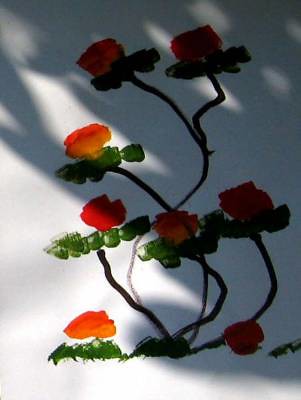 |
| Post impressionist masterpiece |
Bangkok may be hot, humid, grid locked, polluted and frantic but it also
has its architectural treasures like the magnificent temple of the Emerald
Buddha
 |
| Wat Phra Kaew |
Not far from Bangkok is Kanchanaburi, home of the infamous Death Railway
bridge over the River Kwai.
 |
| Saphan Mae Nam Khwae |
Chiang Mai is dominated by mount Doi Suthep on top of which is the
beautiful Phra That Doi Suthep temple where the Buddhist monks
don’t mess about when driving out those impious thoughts.
 |
| Pagoda at Wat Suthep |
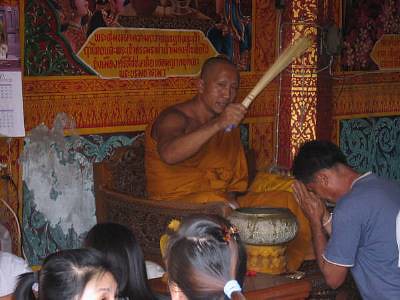 |
| Buddhist monk at Wat Suthep |
Living dangerously with cobras at a snake farm near Chiang Mai.
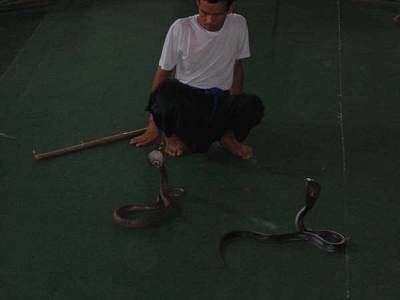 |
| Cobra baiting |
Chilling out with my pipe in the Golden Triangle (where Thailand, Burma and
Laos meet at the confluence of the Nam Ruak and Mekong River) notorious for
its opium production.
 |
| Model in the Opium Museum at Sop Ruak |
There are impressive water falls all over North Thailand but the
Mae Ya waterfall in the Doi Inthanon national
park with its 30+ tiers must be one of the most beautiful.
 |
| Mae Ya waterfall |
And finally, did you guess the artist? This picture just goes to show
what can be done if you really really concentrate.
 |
| The Artist at work |
P.S.
We arrived in Bangkok in mid October, toward the end of the rainy
season. Nothing we had been told quite prepared us for the culture shock of
this teeming frantic city: hot, humid, grid locked, noisy and polluted. But
as we acclimatised and found out how to travel cheaply and quickly around
the city (mainly by Skytrain, express boat, and tuk-tuk (a sort of
motorbike rickshaw driven by the Thai wing of the Kamikaze)) a more
favourable impression emerged: one of friendly people, street markets where
the prices are incredibly low, road side food stalls everywhere selling
tasty Thai food, magnificent Buddhist temples (Wats), numerous thai massage
parlours (stop tittering!), and so on. While in Bangkok we had a day trip
to
